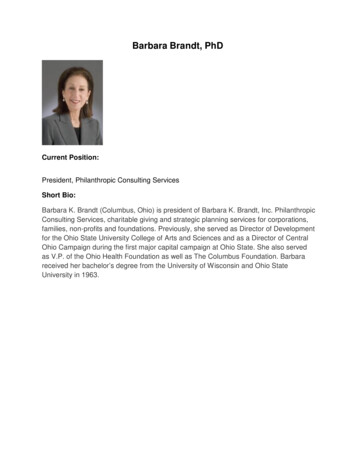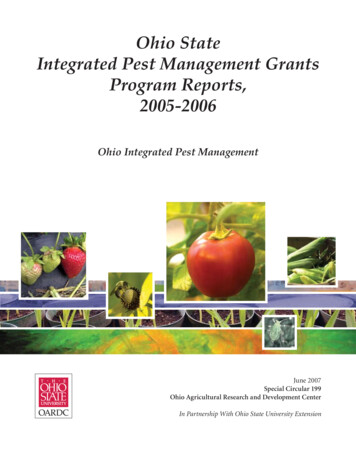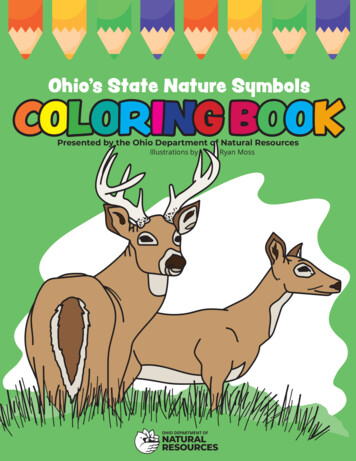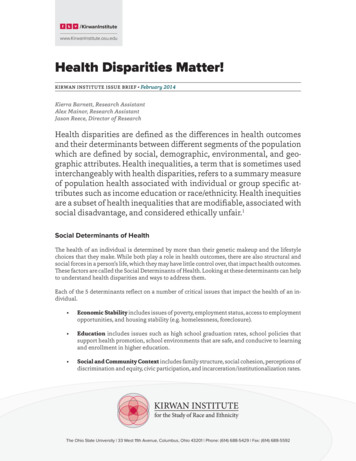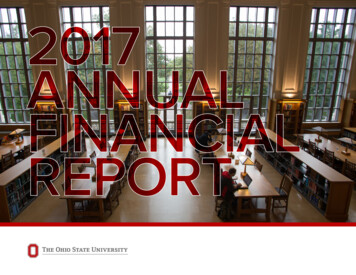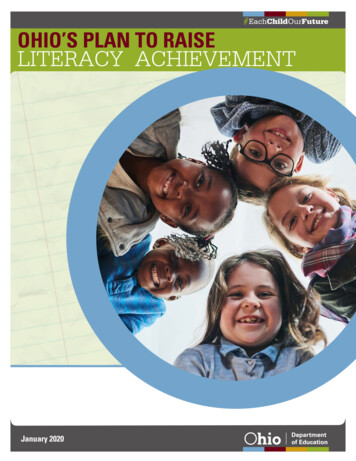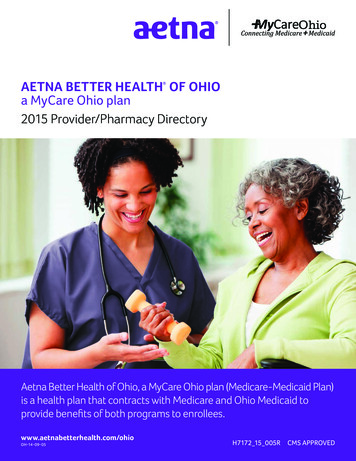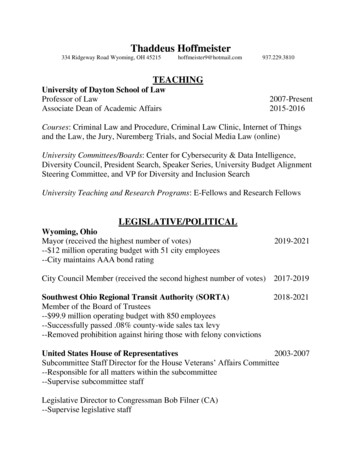
Transcription
Board of Trustees210 Bricker Hall190 North Oval MallColumbus, OH 43210-1321Phone (614) 292-6359Fax (614) 292-5903trustees.osu.eduSTRATEGIC COMPLETION PLANResolution No. 2021-04Synopsis: Approval of the 2020-2022 Strategic Completion Plan, is proposed.WHEREAS Ohio Revised Code 3345.81 requires the Board of Trustees of each Ohio institution of highereducation every two years to adopt a strategic completion plan designed to increase the number of degreesand certificates awarded to students; andWHEREAS The Ohio State University Board of Trustees approved the 2018-2020 strategic completion planon June 8, 2018; andWHEREAS the university has updated the strategic completion plan through 2022:NOW THEREFOREBE IT RESOLVED, That the Board of Trustees hereby approves the 2020-2022 Strategic Completion Plan.CERTIFIEDThis is to certify that the foregoing is a true and accurate excerpt fromthe minutes of the Board of Trustees meeting held August 27, 2020.Jessica A. EvelandSecretary
Completion PlanUpdated August 2020Provided to the Chancellor of the Ohio Department of Higher Educationin accordance with Ohio Revised Code 3345.81Prepared by OSAS Research & Program AssessmentOSAS RPA@osu.edu
The Ohio State University Completion PlanUpdated August 2020Table of ContentsEXECUTIVE SUMMARY. 4UNIVERSITY MISSION AND PROFILE . 5Mission . 5Profile . 6BARRIERS TO PERSISTENCE AND COMPLETION. 7PROGRESS TOWARD GOALS FROM 2018-2020 COMPLETION PLAN . 10UPDATED COMPLETION GOALS . 12CURRENT AND ONGOING COMPLETION STRATEGIES AND ACTIVITES. 13Undergraduate Admissions . 13Need-Based Financial Aid. 13Orientation and First Year Experience . 14Learning Communities . 15Diversity and Inclusion . 16Campus-Change and Transfer. 16Second Year Engagement . 17Advising Community. 18Teaching and Learning. 19Learning Support Services . 22Student Wellness Services. 25Promoting Evidence-Based Practice. 26UPDATED COMPLETION STRATEGIES. 26New Student Orientation and First Year Experience. 27Student Advising and Support . 28Strengthening the Focus on Campus-Change and Transfer . 29Teaching and Learning. 30General Education Redesign . 31Enhanced Support for Students with Disabilities. 33WORKFORCE DEVELOPMENT PRIORITIES . 34Ohio State Choose Ohio First Scholarship Programs . 35Coding Skill Development . 35Bachelor of Science in Engineering Technology . 36Academic Certificates at Ohio State. 36Center for Design and Manufacturing Excellence . 37Student Career Resources . 38Ohio Means Internships and Co-Ops JobReady Program . 40Central Ohio Compact. 412 Page
Ohio State Corporate Engagement Office. 41Industry Liaison Office. 43Appendix A: University Student Profiles . 44Appendix B: Approved Certificate Programs . 46Appendix C: References and Web Links: . 493 Page
EXECUTIVE SUMMARYThe Ohio State University is a comprehensive public university founded in 1870. Itconsists of a selective-admission campus in Columbus; four open-access regionalcampuses in Marion, Newark, Lima and Mansfield; and the Agricultural TechnicalInstitute research campus in Wooster. U.S. News & World Report has ranked OhioState as one of the nation’s top public institutions for more than a decade.Over the past five years, the university has made substantial investments in strategiesdesigned to further improve its already-strong retention and graduation rates, including:dramatically expanding the provision of need-based financial aid; creating at-scale datadriven supports for first-year students; implementing at-scale enrichment opportunitiesfor second-year students; building a data-driven “coordinated care” model of advising;coordinating, highlighting, and scaling teaching improvement efforts across theuniversity; providing iPads to all incoming first-year students and eligible transferstudents; focusing more strongly on the success of identified groups of traditionallyunderserved students, including underrepresented minority, first-generation, Pelleligible, campus-change, and community college transfer students; and creatinginfrastructures to promote evidence-based practices for student success. As a result, inautumn 2019 the Columbus campus showed very strong rates of retention andgraduation (94.1% first-year retention rates and 85.8% six-year graduation rates).The COVID-19 pandemic, which reached Ohio in spring 2020, will pose a number ofchallenges for student persistence and completion. For example, an internal survey ofOhio State undergraduates found that during the initial lockdown in April-May 2020,about a quarter of students experienced food insecurity, about a quarter had computerhardware or an Internet connection that was inadequate for online learning, and abouthalf suffered a serious erosion in their identity as a student. However, Ohio State isworking hard to support all its students through this pandemic and is committed toongoing and new strategic initiatives to support student success, including a redesign ofthe university’s General Education curriculum.This report first lays out the university’s Current and Ongoing Completion Strategiesand Activities, many of which have been in place for several years. Next the reportsummarizes Additional or Updated Completion Strategies, which include thoselaunched in 2019-20 or planned for launch in 2020-21. The latter section includesinformation regarding the university’s response to the COVID-19 crisis and how it plansto support students through the unprecedented context of the 2020-21 academic year.Finally, the report describes how the university is responding to the state’s WorkforceDevelopment Priorities.4 Page
UNIVERSITY MISSION AND PROFILEMissionOhio State is a comprehensive public university founded in 1870. Its largest campus,1,665 acres, is in Columbus, with regional campuses in Marion, Newark, Lima andMansfield. It also has a research campus in Wooster — the Agricultural TechnicalInstitute (ATI)1 — for a total of 16,145 acres. The university’s mission is dedicated to: Creating and discovering knowledge to improve the well-being of our state,regional, national and global communities; Educating students through a comprehensive array of distinguished academicprograms; Preparing a diverse student body to be leaders and engaged citizens; Fostering a culture of engagement and service. Understanding that diversity and inclusion are essential components of ourexcellence.With 15 colleges, Ohio State offers an extensive range of academic programs in theliberal arts, sciences, and the professions. Guided by a strategic plan focused onteaching and learning; access, affordability and excellence; research and creativeexpression; academic health care; and operational excellence and resourcestewardship, 2 Ohio State is focused on uplifting the well-being of the state, the nationand the global community through the dissemination of knowledge. The universityprovides accessible, high quality, undergraduate, graduate and professional educationfor academically qualified students who can benefit from a scholarly environment inwhich research inspires and informs teaching.Ohio State celebrates and learns from diversity and values individual differences.Academic freedom is defended within a community of civility, tolerance and mutualrespect. In the area of teaching and learning, the goal is to provide an unsurpassed,student-centered learning experience led by engaged, world-class faculty and enhancedby a globally diverse student body.ATI is the associate-degree-granting unit of The Ohio State University College of Food, Agricultural andEnvironmental Sciences.2president.osu.edu/strategicplan/15 Page
ProfileThe university’s total autumn 2019 enrollment 3 was 68,262 students, with 61,391 on theColumbus campus. Across campuses, the overall student body was a balanced mix ofmale and female (50.8% female); 74.6% were residents of Ohio and 9.6% wereinternational students; 64.7% were (non-international) white/non-Hispanic; 22.4% were(non-international) minority students, including 6.8% who identified as AfricanAmerican/black, 4.8% Hispanic, 6.8% Asian, and 3.8% who identified as multi-racial.The student body included 875 students who were active duty military or veterans, andan additional 411 in the Reserve Officers’ Training Corps (ROTC).Among Columbus campus students in autumn 2019, 46,818 were undergraduates, andtheir average age was 21 (with 94% under age 25). Most new students entering theColumbus campus were new first-year students (or “NFYS”) with no prior collegeexperience outside of high school dual enrollment (7,630 students). These students’average ACT score was 29.5, with 94% in the top quartile of their graduating class and61% in the top 10%. Most (86%) arrived with accepted credit: 75% arrived with testcredit (such as Advanced Placement, International Baccalaureate, College LevelExamination Program, or language proficiency), and 37% arrived with dual enrollmentcredit. Overall, 28% of NFYS earned 30 or more college credits while still in high school,up from 22% in 2015. In addition to NFYS, the Columbus campus also welcomed 2,415new transfer students from other two- and four-year colleges, as well as 1,372 “campuschange” students who moved from Ohio State regional campuses to the Columbuscampus.Ohio State’s regional campus profile differs from that of the Columbus campus. The fourregional campuses and ATI have an open enrollment policy and serve many studentswho prefer to start their college experience at a smaller university campus. A limitedrange of degrees can be completed on the regional campuses (including both associateand bachelor’s degrees), but most bachelor’s degrees require students to change to theColumbus campus to complete advanced coursework. Ohio residents who apply to theColumbus campus but are not admitted have the option to start at a regional campusand are eligible to change to Columbus after the successful completion of 30 credithours (one year of full-time study). In autumn 2019, Ohio State’s regional campusenrollment was 6,851, of which 3,049 were new first-year students. Regional campusstudents were more likely than Columbus students to be non-traditional: 14.9% werepart time; 84.6% were 18 to 24 years old; and the majority commuted to campus.All data from 2019 Enrollment Services reports; see Appendix A for details. Some program descriptionsare compiled from unit websites and/or promotional material. See Appendix C for a list of relevant OhioState websites.36 Page
Regional NFYS students were also more likely to be Pell-eligible 4 (34.6%, compared to18.2% on the Columbus campus). The average ACT score for NFYS regional studentswas 21.9, and 47.5% needed remediation in math or English or both (compared to 1.7%on the Columbus campus). 5For the 2018-19 academic year, Ohio State awarded 17,145 degrees, including 1,159associate degrees at the regional campuses,11,478 bachelor’s degrees, 2,750 master’sdegrees, 886 doctoral degrees and 802 advanced professional degrees. The averagetime to a bachelor’s degree was 4.21 years.Ohio State has earned national recognition for the quality of its programs and teaching.U.S. News & World Report has ranked Ohio State as one of the nation’s top publicinstitutions for more than a decade; in 2020, Ohio State was ranked No. 7 among publicuniversities nationwide, was recognized in the Best Undergraduate Teaching and MostInnovative Schools categories, had 15 graduate programs ranked in the nation’s top 10,and was ranked No. 1 for online undergraduate education.BARRIERS TO PERSISTENCE AND COMPLETIONThe autumn 2019 report showed high rates of retention and graduation for ColumbusNFYS students, with first-year retention at 94.1% and 85.8% graduating in six yearswith a bachelor’s degree. Success rates were lower on the regional campuses(collectively, excluding ATI); first-year retention was 68.7% and the six-year graduationrate was 42.7%.Students with lower rates of retention and graduation have typically come from one ormore of the following underserved populations: Pell-eligible, first-generation,underrepresented minority or transfer/campus-change. Male students also experienceextended time-to-degree compared to female students. The most recent successmetrics for these students are included below.Students eligible for Pell Grants meet federal guidelines for low and moderate incomes. Pell eligibility is used tomeasure financial need in student populations.5Although the Columbus campus has been deemed remediation-free by the Ohio Department of Higher Education(ODHE), acting according to Section 3345- 061(H) of the Ohio Revised Code, the Columbus campus still hasstudents who are in need of extra support through remedial intervention, particularly in math and Englishcomposition. Of the 7,630 NFYS entering Columbus in Autumn 2019, 132 students were recommended forremedial courses through the university placement exams administered during orientation (107 of whom werereferred for remediation in math, 10 in English, and 15 in both subjects).47 Page
For Pell-eligible Columbus NFYS, first-year retention was 91.5% and six-yeargraduation was 78.3%; for Pell-eligible regional campus NFYS, the respective rateswere 62.6% and 32.2%. For first-generation Columbus NFYS, first-year retention was91.4% and six-year graduation was 79.8%; for first-generation regional campus NFYS,the respective rates were 64.3% and 34.9%. For Columbus NFYS who identify with aracial/ethnic group that is underrepresented, first-year retention was 91.8% and six-yeargraduation was 76.5%.Success rates for transfer and campus-change students are calculated based onstudent “rank” (credit accrual at the point of entry into the Columbus campus). Forexample, students who transfer with fewer than 30 credits are Rank 1, and those whotransfer with more than 90 credits are Rank 4. Transfer and campus-change studentstypically enter Columbus at Rank 2 or 3, and the pattern of outcomes among Rank 2transfer students are representative of the broader group. According to autumn 2019reports, among Rank 2 transfer students, 70.9% graduated within two more years and76.4% graduated within four more years. These rates were similar to those of regionalcampus students who changed to Columbus within their first two years; they had a sixyear graduation rate of 74.0%.Although male students were retained at a similar rate to female students, they hadlower four-year graduation rates, which may be due to extended time-to-degree. AmongColumbus NFYS, the most recent reports show that one-year retention was 93.4% formen and 94.8% for women. A wide gender gap appeared at four-year graduation, with a58.5% four-year graduation rate for men and a 75.2% rate for women; however, the gapnarrowed at six-year graduation, with a 82.6% six-year graduation rate for men and a89.2% rate for women. The four-year graduation rate for males may be influenced by alarger number of males in engineering, a degree that tends to take longer to completebecause of its accreditation requirements.The COVID-19 pandemic will also pose a number of challenges for student persistenceand completion. For example, an internal survey of Ohio State undergraduates foundthat during the period in April-May 2020 when the university transitioned to virtualteaching and learning, about a quarter of students experienced food insecurity, about aquarter had computer hardware or an Internet connection that was inadequate for onlinelearning, and about half suffered a serious erosion in their identity as a student.According to a May-June 2020 survey of students at major research universities similarto Ohio State, 9% of continuing students were still unsure whether they would re-enrollin the fall. 6 Moving into the 2020-21 academic year, economic uncertainties and healthrisks associated with the pandemic are likely to be exacerbated among Pell-eligible,Will students come back?: Undergraduate students’ plans to re-enroll in Fall 2020. SERU COVID-19 Survey PolicyBrief, cshe.berkeley.edu/seru68 Page
first-generation, and other groups of traditionally underserved students. However, OhioState is working hard to support all its students through this pandemic and is aiming tomaintain strong retention numbers this fall.9 Page
PROGRESS TOWARD GOALS FROM 2018-2020 COMPLETION PLANThe following were goals for the 2018 plan. Progress for each is provided. Goal 1: Increase Columbus NFYS first-year retention from 94.2% to 95.0% by2020.Progress: After small but steady increases in prior years, Ohio State’s retentionrate stabilized and is now at 94.1%. Goal 2: Increase the overall number of degrees completed in four years by 1%each year.Progress: The four-year graduation rate increased on Columbus campus from62.4% in 2017 to 67.0% in 2019 – more than double the goal of increasing fouryear graduation rates by 1 percentage point per year. Goal 3: Continue to increase the completion and retention rates of underservedpopulations, including first-generation, Pell-eligible, transfer/campus-change, andAfrican-American/black students.Progress: As the table below shows, the university continues to make progresson first-year retention and four-year graduation rates for these subpopulations,although retention from the second to third year (“second-year retention”) is downfor some subpopulations. Goal 4: Enhance college-to-career and post-graduate pathways, with a focus onOhio workforce development priorities.Progress: Ohio State is strengthening existing strategies and has launched newstrategies related to this goal, as detailed later in the report.10 P a g e
Retention and Graduation Rates - Columbus Campus*20172019First Year Retention - All Students94.2%94.1%Second Year Retention - All Students91.1%90.6%Four-Year Graduation - All Students62.4%67.0%Six-Year Graduation - All Students82.5%85.8%First Year Retention – First-Generation91.2%91.4%Second Year Retention - First-Generation86.9%85.2%Four-Year Graduation - First-Generation53.9%59.9%Six-Year Graduation - First-Generation75.1%79.8%First Year Retention - Pell-Eligible90.2%91.5%Second Year Retention - Pell-Eligible88.1%86.7%Four-Year Graduation - Pell-Eligible52.5%58.1%Six-Year Graduation - Pell-Eligible74.4%78.3%First Year Retention – African American / Black90.6%93.0%Second Year Retention – African American / Black85.9%87.4%Four-Year Graduation – African American / Black44.0%49.5%Six-Year Graduation – African American / Black73.4%73.8%* First year retention rates are based on 2016 and 2018 NFYS. Second yearretention rates are based on 2015 and 2017 NFYS. Four-year graduation rates arebased on 2012 and 2015 NFYS. Six-year graduation rates are based on 2011 and2013 NFYS.11 P a g e
UPDATED COMPLETION GOALSIn light of the critical challenges that the COVID-19 pandemic poses for Ohio Statestudents, instructional faculty and student support staff, the university will seek tomaintain its gains in terms of student retention and completion over the 2020-21academic year. The economic consequences of the pandemic for students and theirfamilies will likely resonate through 2021-22 as well. Despite these challenges, theuniversity is committed to maintaining its recent retention and graduation gains through2022, particularly for traditionally underserved students who may be affected mostnegatively by the pandemic.Goal 1: Maintain NFYS Columbus retention at 2019-20 levels.Goal 2: Maintain NFYS Columbus four-year and six-year graduation rates at 2019–20levels.Goal 3: Maintain 2019-20 levels of completion and retention for traditionallyunderserved populations, including first-generation, Pell-eligible, transfer/campuschange, and African-American/black students.Goal 4: Continue to enhance and build college-to-career and post-graduate pathways,with a focus on Ohio workforce development priorities.In the following sections, the report first lays out the university’s Current and OngoingCompletion Strategies and Activities. These activities reflect the university’s ongoingprocesses to strengthen completion, many of which have been in place for severalyears. Next the report summarizes Additional or Updated Completion Strategies,which include strategies that were launched in 2019–20 or are planned for launch in2020–21. The latter section includes information regarding the university’s response tothe COVID-19 crisis and how it plans to support students through the unprecedentedcontext of the 2020–21 academic year. Finally, the report describes how the universityis responding to the state’s Workforce Development Priorities.12 P a g e
CURRENT AND ONGOING COMPLETION STRATEGIES AND ACTIVITIESThe university’s completion strategies are implemented in partnership between theOffice of Student Academic Success (OSAS), the Office of Student Life, the Office ofDiversity and Inclusion (ODI), the Drake Institute for Teaching and Learning, the Officeof Distance Education and e-Learning (ODEE), University Libraries, and the university’sacademic colleges and campuses. Below, the university’s ongoing completion activitiesare organized by function, with most representing a collaboration across multiple units.Such collaborations are coordinated through key strategic initiatives and infrastructures(such as the rollout of the new framework for General Education, discussed later in thisreport).Undergraduate AdmissionsUndergraduate Admissions provides robust outreach to historically underrepresentedstudents of color, first-generation, and limited-income students through proactiveoutreach, partnerships and individual engagement. Working closely with communitybased organizations, such as I Know I Can, the Cincinnati Youth Collaborative, CollegeNow Greater Cleveland, KIPP Columbus, Strive for College, and Chicago Scholars,admissions staff work with high school counselors throughout the state, especially inurban and rural areas, to educate counselors on the OSU admissions process. OhioState’s unique Buckeye Student Leadership Academy helps to prepare selected risingseniors from underrepresented backgrounds in Ohio for the application process, free toparticipants. Student telecounselors, faculty, and staff conduct outreach through phonecall and email campaigns to build individual relationships with prospective students.After admission, Undergraduate Admissions provides travel grants for targeted admittedstudents to help defray the cost of coming to campus for admitted student programs.Specialized programming to help build community for underrepresented students takesplace at off-campus programs in Cincinnati and Cleveland, as well as during admittedstudent visits on campus.Need-Based Financial AidOver the past five years Ohio State has significantly expanded its portfolio ofinstitutional need-based aid in order to remove financial barriers to student success andcompletion. In 2015, Ohio State launched the President’s Affordability Grant Program toprovide new need-based aid to low- and middle-income students on the Columbuscampus; the program was expanded to the regional campuses in 2016–17. In autumn2018, the university launched the Buckeye Opportunity Program on the Columbus13 P a g e
campus, which supports students from Ohio who qualify for a Federal Pell Grant; eachrecipient receives enough student financial aid to cover the full cost of undergraduatetuition and mandatory fees. The program was expanded to the regional campuses inspring 2019.Orientation and First Year ExperienceA comprehensive orientation for NFYS, transfer students and special populations (forexample, veterans) is important for students (and families) so they can begin to focuson college and start the transition to life as an Ohio State student. In addition tomanaging logistical tasks such as placement testing, course scheduling and financialaid consultation, Ohio State’s student orientation sessions contribute to first-yearretention by ensuring that students: Learn about resources and expectations both inside and outside of theclassroom. Engage with their Peer Leader, who provides support during orientation andthroughout the first year. Meet one-on-one with academic advisors to learn about academic areas ofstudy.After arriving at Ohio State, all new first-year students participate in university First YearExperience (FYE) programs designed to help students become acclimated to campus,connect with resources and the university community, and to start to think of Ohio Stateas their second home.First Year Experience uses predictive modeling to help identify students who may needmore intensive support. On the Columbus campus, a key piece of the intensive supportstrategy is implemented by Peer Leaders: every new first-year student is assigned aspecific Peer Leader, an upper-class student who leads the new student’s two-daysummer orientation, maintains connections with that student through the entirety of thefirst year, and helps provide or coordinate more intensive or sustained support forstudents who need it most.Across all campuses, every new first-year student enrolls in the University Surveycourse, a one-credit hour course taught by academic advisors in their own major orcollege, in which students are encouraged to set goals, complete two- and four-yearcurricular plans, and delineate courses that must be taken sequentially to complete thedegree on time. The course is designed as an extended introduction to the university. Itcovers majors and colleges, how to schedule classes, intentional degree planning, howto conduct other Ohio State business, and using resources such as the library systemand other academic and personal services.14 P a g e
As part of Survey course requirements, students attend First Year Success Seriessessions, which reinforce content provided in the survey course and focus on helpingstudents overcome common challenges during the transition to college. A special track,Buckeye START, has been created in the Success Series for populations of studentswho often navigate additional barriers to success throughout their first year; specifically,these populations include first generation students, students who commute, studentsfrom limited-income backgrounds, and students of color (particularly men of color). Thisopportunity is only for students who are identified by FYE through a data-informedapproach or referred to FYE by a campus partner, in order to ensure the students whocan most benefit have the chance to take advantage of this experience and support.Buckeye START sessions are intended to help these students recognize and normalizethe transition to college, connect new students to campus resources that can mostappropriately support their success, and foster peer connections among new studentsand with FYE Peer Leaders.Learning CommunitiesAll first- and second-year Columbus NFYS are required to live on campus unless theyare granted a waiver. This residential requirement allows the university to integrate ava
WHEREAS Ohio Revised Code 3345.81 requires the Board of Trustees of each Ohio institution of higher educ ation every two years to adopt a strategic completion plan designed to increase the number of degrees and certificates awarded to students; and WHEREAS The Ohio State University Board of Trustees approved the 2018-2020 strategic completion plan
